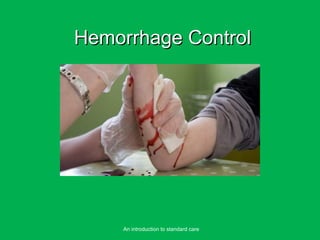
Hemorrhage control
- 1. Hemorrhage ControlHemorrhage Control An introduction to standard care
- 2. 22 IntroductionIntroduction Review methods of hemorrhage control inReview methods of hemorrhage control in the pre-hospital setting.the pre-hospital setting. Hemorrhage is the leading cause ofHemorrhage is the leading cause of preventable death in trauma.preventable death in trauma. Hemorrhage control save lives.Hemorrhage control save lives.
- 4. 44 Blood VesselsBlood Vessels ArteriesArteries ArteriolesArterioles CapillariesCapillaries VenulesVenules VeinsVeins
- 5. 55 PulsesPulses Left ventricle contracts.Left ventricle contracts. Peripheral pulses:Peripheral pulses: – RadialRadial – BrachialBrachial – Posterior tibialPosterior tibial – Dorsalis pedisDorsalis pedis Central pulses:Central pulses: – CarotidCarotid – FemoralFemoral
- 6. 66 BloodBlood Adult body:Adult body: – Contains approximately 5 to 6 liters of bloodContains approximately 5 to 6 liters of blood – Loss of 1 pint of blood without harmful effectsLoss of 1 pint of blood without harmful effects – Loss of 2 pints may cause shockLoss of 2 pints may cause shock Three phases ofThree phases of hemostasis:hemostasis: – Vascular spasmVascular spasm – Platelet plug formationPlatelet plug formation – Blood clottingBlood clotting (coagulation cascade)(coagulation cascade)
- 7. 77 HemorrhageHemorrhage Pulse vs. Blood Pressure.Pulse vs. Blood Pressure. How long until there are changes?How long until there are changes? Young healthy adults compensate for longYoung healthy adults compensate for long periods, then decompensate rapidly.periods, then decompensate rapidly. At what blood pressure do casualties loseAt what blood pressure do casualties lose consciousness?consciousness? ─ @ 50 mm Hg@ 50 mm Hg
- 8. 88 Clinical Signs of Acute HemorrhageClinical Signs of Acute Hemorrhage ClassClass % Blood% Blood LossLoss Clinical SignsClinical Signs II Up to 750 mlUp to 750 ml (15%)(15%) Slight increase in HR; no change in BPSlight increase in HR; no change in BP or respirationsor respirations IIII 750-1500 ml750-1500 ml (15-30%)(15-30%) Increased HR and respirations;Increased HR and respirations; increased diastolic BP; anxiety, fright orincreased diastolic BP; anxiety, fright or hostilityhostility IIIIII 1500-20001500-2000 ml (30-40%)ml (30-40%) Increased HR and respirations; fall inIncreased HR and respirations; fall in systolic BP; significantsystolic BP; significant AMSAMS IVIV >2000>2000 (>40%)(>40%) Severe tachycardia; severe lowering ofSevere tachycardia; severe lowering of BP; cold, pale skin; severe AMSBP; cold, pale skin; severe AMS
- 9. 99 Sources of HemorrhageSources of Hemorrhage External:External: – Visible blood is hard to estimateVisible blood is hard to estimate Internal:Internal: – May be hidden within the torso or even inMay be hidden within the torso or even in the extremities secondary to fracturesthe extremities secondary to fractures
- 10. 1010 Sources of External BleedingSources of External Bleeding Arterial:Arterial: ─Rapid, profuse and pulsatingRapid, profuse and pulsating ─Bright red in colorBright red in color Venous:Venous: ─Steady flowSteady flow ─Dark red or maroon in colorDark red or maroon in color Capillary:Capillary: ─Slow and oozingSlow and oozing ─Often clots spontaneouslyOften clots spontaneously
- 11. 1111 Extremity HemorrhageExtremity Hemorrhage Click on picture for video
- 12. 1212 Internal Signs of HemorrhageInternal Signs of Hemorrhage Soft tissue bruising.Soft tissue bruising. Abdominal tenderness.Abdominal tenderness. Hemoptysis.Hemoptysis. Hematemesis.Hematemesis. Melena.Melena.
- 13. 1313 Injured Internal OrgansInjured Internal Organs
- 14. 1414 Hemorrhage ControlHemorrhage Control Expose the wound.Expose the wound. Attempt to control theAttempt to control the bleeding with directbleeding with direct pressure or a pressurepressure or a pressure dressing.dressing.
- 15. 1515 Hemorrhage ControlHemorrhage Control Life-threatening arterial bleedingLife-threatening arterial bleeding (amputation) may require early use of a(amputation) may require early use of a tourniquet.tourniquet. If under enemy fire or in a dangerousIf under enemy fire or in a dangerous position rapidly apply a tourniquet andposition rapidly apply a tourniquet and move casualty to cover.move casualty to cover.
- 16. 1616 TourniquetsTourniquets Several new tourniquets have beenSeveral new tourniquets have been selected as primary means to controlselected as primary means to control hemorrhage in combat.hemorrhage in combat.
- 17. 1717 Improvised TourniquetImprovised Tourniquet Place cravat between heart and wound.Place cravat between heart and wound. Tie a half-knot on upper surface.Tie a half-knot on upper surface. Place a short stick on half-knot.Place a short stick on half-knot. Tie a square knot on top ofTie a square knot on top of stick.stick. Twist stick (windlass) toTwist stick (windlass) to tighten.tighten. UNTIL BLEEDING STOPS.UNTIL BLEEDING STOPS. Secure windlass to prevent unwinding.Secure windlass to prevent unwinding.
- 19. 1919 Tourniquet PrinciplesTourniquet Principles Never cover a tourniquet.Never cover a tourniquet. Never remove the tourniquet once placedNever remove the tourniquet once placed unless directed by medical control.unless directed by medical control. Understand the tourniquets are painfulUnderstand the tourniquets are painful and the patient may plead with you toand the patient may plead with you to remove it.remove it.
- 20. 2020 AmputationAmputation Apply a pressure dressing to cover theApply a pressure dressing to cover the end of the stump.end of the stump. Kerlix and 6” Ace wrap for effectiveKerlix and 6” Ace wrap for effective pressure dressing.pressure dressing. Rinse amputated part free of debris.Rinse amputated part free of debris. Wrap loosely in saline-moistened sterileWrap loosely in saline-moistened sterile gauze.gauze.
- 21. CMASTCMAST 2121 Preservation of Amputation PartsPreservation of Amputation Parts Seal amputated part in a plastic bag orSeal amputated part in a plastic bag or cravat.cravat. Place in a cool container; do not allow toPlace in a cool container; do not allow to freeze.freeze. Never place an amputated part in water.Never place an amputated part in water. Never place amputated part directly on ice.Never place amputated part directly on ice. Never use dry ice to cool an amputatedNever use dry ice to cool an amputated part.part.
- 22. 2222 Treatment GoalsTreatment Goals Hemorrhage control continues to be theHemorrhage control continues to be the priority in pre-hospital care.priority in pre-hospital care. Hemorrhage is the leading cause ofHemorrhage is the leading cause of preventable death in trauma.preventable death in trauma. Our focus must be on stopping patientsOur focus must be on stopping patients from bleeding to death, and rapidfrom bleeding to death, and rapid transport to a surgical facility.transport to a surgical facility.